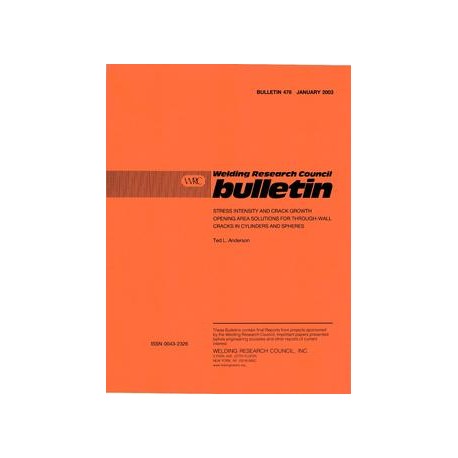Cart 0 Product Products (empty)
No products
To be determined Shipping
$0.00 Total
Product successfully added to your shopping cart
Quantity
Total
There are 0 items in your cart. There is 1 item in your cart.
Total products
Total shipping To be determined
Total
New Reduced price!  View larger
View larger
 View larger
View larger WRC 478
M00000557
New product
WRC 478 Stress Intensity And Crack Growth Opening Area Solutions For Through-Wall Cracks In Cylinders And Spheres
Bulletin / Circular by Welding Research Council, 2003
T. L. Anderson
In stock
More info
Full Description
WRC Bulletin 471 reports KI solutions for part-through cracks in cylindrical and spherical shells. WRC Bulletin 478 provides KI and crack opening area (COA) solutions for through-wall cracks in cylindrical and spherical shells. The work reported in Bulletin 478 uses over 450 finite element runs. FEA-Crack software is used to automate the tasks of generating the models, running the analyses, and post-processing the results. FEA-Crack includes an automatic mesh generator that creates finite element models of structures with cracks based on user-specified dimensions. For a given geometry, FEA-Crack creates multiple meshes with various crack sizes.Linear elastic finite element analyses, as well as a limited number of elastic-plastic analyses, were performed with the WARP3D program (developed at the University of Illinois).
FEA-Crack performs the post-processing of results, and J integral values are extracted from each results file and are converted to equivalent KI values. These stress intensity values are non-dimensionalized. Crack opening area (COA) on both the inside surface and outside surface are computed for each model and non-dimensionalized.
Section 9 of the American Petroleum Institute (API) Recommended Practice on Fitness for Service (RP 579) [1] contains assessment procedures for crack-like flaws. One of the key components of a crack propagation or fracture analysis is the applied stress intensity factor, KI, of the structure of interest, where KI is a measure of crack driving force that depends on applied stress, crack size, and the geometry of the structure.
Appendix C of API RP 579 contains a compendium of KI solutions for a variety of geometries. Most of these solutions were obtained from the published literature. Unfortunately, KI solutions for many configurations of practical interest are not available in the literature. Solutions for cracks at structural discontinuities such as nozzles are virtually nonexistent in the published literature. Even for simple cases, existing solutions are often unsatisfactory.

